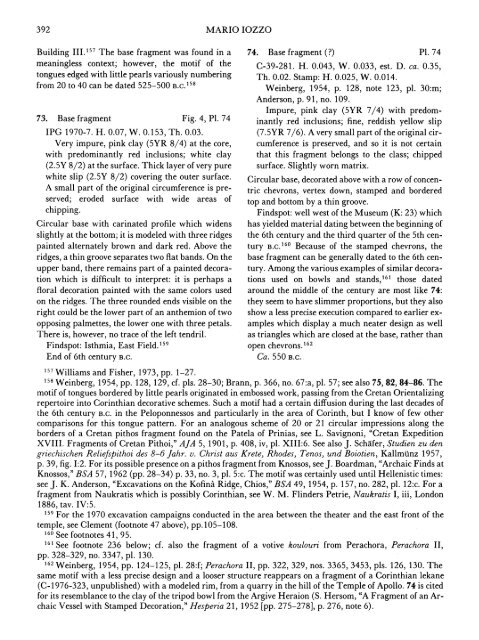f - The American School of Classical Studies at Athens
f - The American School of Classical Studies at Athens
f - The American School of Classical Studies at Athens
Create successful ePaper yourself
Turn your PDF publications into a flip-book with our unique Google optimized e-Paper software.
392 MARIO IOZZO<br />
Building III.157 <strong>The</strong> base fragment was found in a<br />
meaningless context; however, the motif <strong>of</strong> the<br />
tongues edged with little pearls variously numbering<br />
from 20 to 40 can be d<strong>at</strong>ed 525-500 B.C.158<br />
73. Base fragment Fig. 4, P1. 74<br />
IPG 1970-7. H. 0.07, W. 0.153, Th. 0.03.<br />
Very impure, pink clay (5YR 8/4) <strong>at</strong> the core,<br />
with predominantly red inclusions; white clay<br />
(2.5Y 8/2) <strong>at</strong> the surface. Thick layer <strong>of</strong> very pure<br />
white slip (2.5Y 8/2) covering the outer surface.<br />
A small part <strong>of</strong> the original circumference is preserved;<br />
eroded surface with wide areas <strong>of</strong><br />
chipping.<br />
Circular base with carin<strong>at</strong>ed pr<strong>of</strong>ile which widens<br />
slightly <strong>at</strong> the bottom; it is modeled with three ridges<br />
painted altern<strong>at</strong>ely brown and dark red. Above the<br />
ridges, a thin groove separ<strong>at</strong>es two fl<strong>at</strong> bands. On the<br />
upper band, there remains part <strong>of</strong> a painted decora-<br />
tion which is difficult to interpret: it is perhaps a<br />
floral decor<strong>at</strong>ion painted with the same colors used<br />
on the ridges. <strong>The</strong> three rounded ends visible on the<br />
right could be the lower part <strong>of</strong> an anthemion <strong>of</strong> two<br />
opposing palmettes, the lower one with three petals.<br />
<strong>The</strong>re is, however, no trace <strong>of</strong> the left tendril.<br />
Findspot: Isthmia, East Field.159<br />
End <strong>of</strong> 6th century B.C.<br />
74. Base fragment (?) P1. 74<br />
C-39-281. H. 0.043, W. 0.033, est. D. ca. 0.35,<br />
Th. 0.02. Stamp: H. 0.025, W. 0.014.<br />
Weinberg, 1954, p. 128, note 123, pl. 30:m;<br />
Anderson, p. 91, no. 109.<br />
Impure, pink clay (5YR 7/4) with predom-<br />
inantly,red inclusions; fine, reddish yellow slip<br />
(7.5YR 7/6). A very small part <strong>of</strong> the original cir-<br />
cumference is preserved, and so it is not certain<br />
th<strong>at</strong> this fragment belongs to the class; chipped<br />
surface. Slightly worn m<strong>at</strong>rix.<br />
Circular base, decor<strong>at</strong>ed above with a row <strong>of</strong> concen-<br />
tric chevrons, vertex down, stamped and bordered<br />
top and bottom by a thin groove.<br />
Findspot: well west <strong>of</strong> the Museum (K: 23) which<br />
has yielded m<strong>at</strong>erial d<strong>at</strong>ing between the beginning <strong>of</strong><br />
the 6th century and the third quarter <strong>of</strong> the 5th cen-<br />
tury B.C.160 Because <strong>of</strong> the stamped chevrons, the<br />
base fragment can be generally d<strong>at</strong>ed to the 6th cen-<br />
tury. Among the various examples <strong>of</strong> similar decora-<br />
tions used on bowls and stands,'16 those d<strong>at</strong>ed<br />
around the middle <strong>of</strong> the century are most like 74:<br />
they seem to have slimmer proportions, but they also<br />
show a less precise execution compared to earlier ex-<br />
amples which display a much ne<strong>at</strong>er design as well<br />
as triangles which are closed <strong>at</strong> the base, r<strong>at</strong>her than<br />
open chevrons.'62<br />
Ca. 550 B.C.<br />
157 Williams and Fisher, 1973, pp. 1-27.<br />
158 Weinberg, 1954, pp. 128, 129, cf. pls. 28-30; Brann, p. 366, no. 67:a, pl. 57; see also 75, 82, 84-86. <strong>The</strong><br />
motif <strong>of</strong> tongues bordered by little pearls origin<strong>at</strong>ed in embossed work, passing from the Cretan Orientalizing<br />
repertoire into Corinthian decor<strong>at</strong>ive schemes. Such a motif had a certain diffusion during the last decades <strong>of</strong><br />
the 6th century B.C. in the Peloponnessos and particularly in the area <strong>of</strong> Corinth, but I know <strong>of</strong> few other<br />
comparisons for this tongue p<strong>at</strong>tern. For an analogous scheme <strong>of</strong> 20 or 21 circular impressions along the<br />
borders <strong>of</strong> a Cretan pithos fragment found on the P<strong>at</strong>ela <strong>of</strong> Prinias, see L. Savignoni, "Cretan Expedition<br />
XVIII. Fragments <strong>of</strong> Cretan Pithoi," AJA 5, 1901, p. 408, iv, pl. XIII:6. See also J. Schafer, Studien zu den<br />
griechischen Reliefspithoi des 8-6 Jahr. v. Christ aus Krete, Rhodes, Tenos, und Boiotien, Kallmunz 1957,<br />
p. 39, fig. 1:2. For its possible presence on a pithos fragment from Knossos, see J. Boardman, "Archaic Finds <strong>at</strong><br />
Knossos," BSA 57, 1962 (pp. 28-34) p. 33, no. 3, pl. 5:c. <strong>The</strong> motif was certainly used until Hellenistic times:<br />
see J. K. Anderson, "Excav<strong>at</strong>ions on the K<strong>of</strong>ina Ridge, Chios," BSA 49, 1954, p. 157, no. 282, pl. 12:c. For a<br />
fragment from Naukr<strong>at</strong>is which is possibly Corinthian, see W. M. Flinders Petrie, Naukr<strong>at</strong>is I, iii, London<br />
1886, tav. IV:5.<br />
159 For the 1970 excav<strong>at</strong>ion campaigns conducted in the area between the the<strong>at</strong>er and the east front <strong>of</strong> the<br />
temple, see Clement (footnote 47 above), pp.105-108.<br />
160 See footnotes 41, 95.<br />
161 See footnote 236 below; cf. also the fragment <strong>of</strong> a votive koulouri from Perachora, Perachora II,<br />
pp. 328-329, no. 3347, pl. 130.<br />
162 Weinberg, 1954, pp. 124-125, pl. 28:f; Perachora II, pp. 322, 329, nos. 3365, 3453, pls. 126, 130. <strong>The</strong><br />
same motif with a less precise design and a looser structure reappears on a fragment <strong>of</strong> a Corinthian lekane<br />
(C- 1976-323, unpublished) with a modeled rim, from a quarry in the hill <strong>of</strong> the Temple <strong>of</strong> Apollo. 74 is cited<br />
for its resemblance to the clay <strong>of</strong> the tripod bowl from the Argive Heraion (S. Hersom, "A Fragment <strong>of</strong> an Archaic<br />
Vessel with Stamped Decor<strong>at</strong>ion," Hesperia 21, 1952 [pp. 275-278], p. 276, note 6).

















